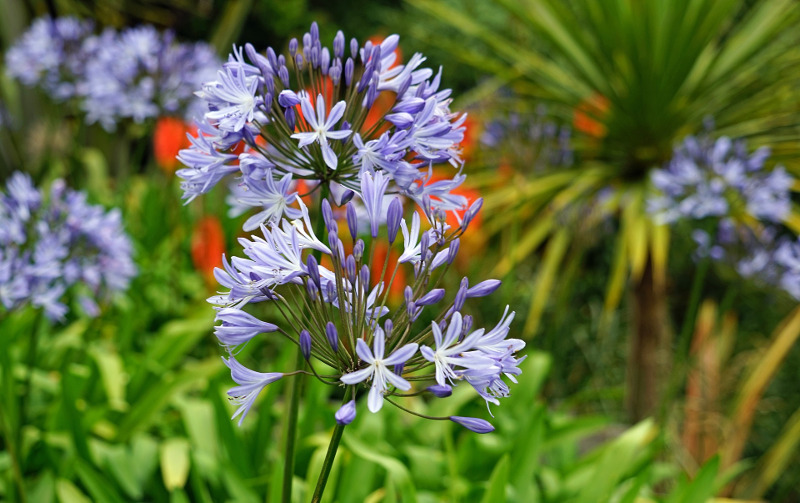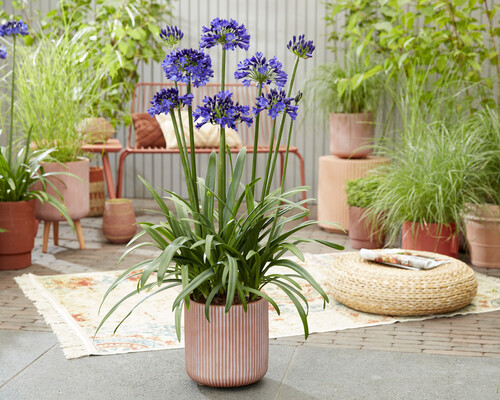Agapanthus Varieties: Selecting the very best for Your Landscape
Agapanthus Varieties: Selecting the very best for Your Landscape
Blog Article
Letting Loose the Secret to Effective Agapanthus Cultivation: Idea for a Flourishing Garden
In the realm of gardening, growing agapanthus efficiently requires a critical strategy that includes numerous aspects of plant care. With mindful attention to detail, one can open the secrets to supporting these spectacular blossoms, bring about a garden that flourishes with appeal and vibrancy. By recognizing the nuances of agapanthus cultivation, one can develop a setting where these plants prosper and bloom abundantly. In the adhering to discussion, we will explore important tips and techniques that will certainly guide you towards a growing agapanthus garden, offering understandings into finest practices, soil conditions, sprinkling methods, and a lot more.
Growing Agapanthus: Finest Practices
When planting Agapanthus, correct dirt preparation is necessary for guaranteeing successful growth and advancement of these lovely blossoms. Agapanthus, generally referred to as Lily of the Nile or African lily, flourishes in well-draining soil with a slightly acidic to neutral pH level - Agapanthus. Prior to growing, it is important to modify hefty clay soils with organic matter such as compost or peat moss to improve drain and supply important nutrients for the plants
To plant Agapanthus, select a place that receives full sunshine to partial color, as this will certainly advertise healthy growth and bountiful flowering. Dig an opening two times the size of the plant's root round and position the Agapanthus at the very same deepness it was previously growing. Delicately backfill the opening with soil, pushing down securely to get rid of any type of air pockets around the roots.
Water the recently planted Agapanthus extensively and continue to keep the soil uniformly damp, especially during the plant's energetic growing season. Agapanthus. Using a well balanced fertilizer once a month can further support the plant's development and flowering. By adhering to these ideal practices for growing Agapanthus, you can develop a stunning display of these captivating blossoms in your yard
Suitable Soil Conditions for Agapanthus
For optimal growth and flowering success of Agapanthus plants, ensuring the dirt problems are excellent is vital. Agapanthus flourishes in well-draining soil with a slightly acidic to neutral pH degree ranging from 6.0 to 7.0. This kind of dirt permits for sufficient water drainage, avoiding waterlogging which can result in root rot. To boost dirt drainage, consider adding raw material such as compost or peat moss when preparing the growing site. Furthermore, Agapanthus favors dirt that is rich in nutrients, so including a well balanced fertilizer during the expanding season can advertise healthy growth and lively blossoms.

Watering and Fertilizing Tips
To make sure healthy and balanced development and vibrant flowers, correct watering and fertilizing techniques are necessary for effective Agapanthus growing. Agapanthus plants benefit from regular watering, specifically throughout the expanding period. It is suggested to water deeply once a week, making certain the soil is moist but not saturated. Throughout heat or in pots, more frequent watering may be required to avoid the soil from drying entirely.
When it involves fertilizing Agapanthus, a balanced fertilizer with equal parts nitrogen, phosphorus, and potassium can be applied in the spring to advertise healthy and balanced growth and flowering. Slow-release plant foods are suitable for offering nutrients progressively over an extended period. Avoid over-fertilizing, as this can cause excessive foliage development at the expense of flowers.
In addition, incorporating raw material like garden compost into the dirt can boost nutrient levels and enhance soil framework, assisting in the overall health and wellness of the Agapanthus plants. By adhering to these watering and feeding pointers, garden enthusiasts can guarantee their Agapanthus plants thrive and generate spectacular display screens of flowers.
Pruning and Deadheading Methods
Appropriate pruning and deadheading techniques play a crucial function in preserving the health and aesthetic appeals of Agapanthus plants, matching the essential practices of watering and fertilizing for successful growing. Trimming Agapanthus includes eliminating spent flower heads, dead or yellowing leaves, and total shaping of the plant to promote better development. Deadheading, the process of getting rid of discolored blossoms, not only enhances the plant's look yet additionally urges further blooming.
When deadheading Agapanthus, it is advisable to snip off the blossom stem at the base making use of sharp, tidy shears. This procedure reroutes the plant's power from seed manufacturing back into origin and vegetation growth, promoting a healthier and more durable plant. Regular deadheading can extend the blooming duration of Agapanthus and stop self-seeding, which can lead to overcrowding.
In regards to trimming, Agapanthus generally take advantage of a light trim after flowering to clean the plant and motivate fresh development. Cutting back the spent flower stems and getting rid of any additional resources type of dead or damaged foliage assists preserve the plant's vigor and general appearance. However, it is important to avoid cutting into the crown of the plant, view publisher site as this can deteriorate its wellness.

Protecting Agapanthus From Vermins and Diseases
Carrying out reliable pest and condition monitoring techniques is critical to securing the wellness and vitality of Agapanthus plants in cultivation. One common pest that influences Agapanthus is the Agapanthus borer, a caterpillar that tunnels right into the plant, triggering damage to the fallen leaves and flowers.
Along with insects, Agapanthus are prone to conditions such as origin rot and fungal leaf spots. These issues can frequently be protected against by making certain appropriate drainage and staying clear of overwatering. Influenced components of the plant need to be without delay removed to prevent additional spread if indicators of illness appear. Fungicides may additionally be utilized as a therapy measure, following the maker's directions thoroughly. By staying attentive and addressing insect and illness visit this web-site issues immediately, gardeners can help their Agapanthus flourish and thrive.

Conclusion
Finally, effective cultivation of agapanthus needs appropriate planting strategies, ideal dirt problems, ample watering and fertilizing, regular pruning and deadheading, and protection from illness and insects. By adhering to these tricks and ideas, garden enthusiasts can guarantee a flourishing garden loaded with gorgeous agapanthus blossoms. Agapanthus. Bear in mind to preserve constant treatment and attention to detail to promote the wellness and longevity of these spectacular plants
When growing Agapanthus, proper dirt prep work is necessary for making sure successful development and advancement of these lovely blossoms.Water the newly planted Agapanthus thoroughly and continue to maintain the soil evenly wet, especially during the plant's active expanding period.For optimum development and flowering success of Agapanthus plants, ensuring the dirt problems are ideal is important. When transplanting or growing Agapanthus, guarantee the soil is well-prepared to offer the needed structure for the plants to develop themselves successfully. One common bug that influences Agapanthus is the Agapanthus borer, a caterpillar that passages right into the plant, causing damages to the leaves and blossoms.
Report this page